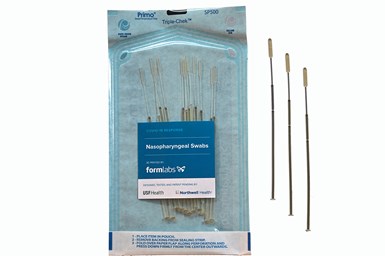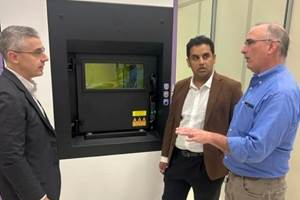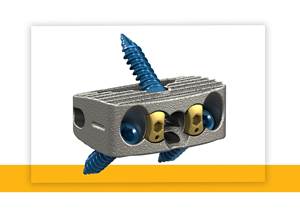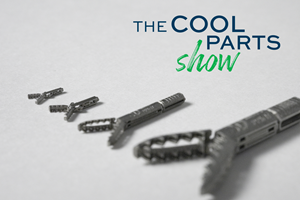Formlabs Recognized for 3D Printed Nasal Swab Used in Pandemic
Group of experts quickly came together in early 2020 to create a 3D printed nasopharyngeal swab, which has been produced around the globe more than 100 million times using the USF-patented design.
Due to the urgent need worldwide, the 3D printed NP swab team decided to forgo monetization of its invention and provided the design files and clinical data at no cost to hospitals, clinics and licensed medical device companies around the world as long as the swabs were produced for their own use. Photo Credit: Formlabs
The University of South Florida (USF) has been awarded the Patents for Humanity award by the U.S. Patent and Trademark Office (USPTO) for its patent of the 3D printed nasopharyngeal (NP) swab. The swab was created in the early part of the pandemic as a solution to the disrupted commercial production of standard flocked NP swabs which are critical in diagnostic testing for COVID-19.
USF is among an exclusive group of winners receiving this year’s Patents for Humanity awards, being named alongside the National Institute of Allergy and Infectious Diseases of the NIH, Regeneron Pharmaceuticals, Gilead Sciences Inc. and Caron Products.
The university earned this recognition for an innovative solution to the commercial NP swab shortage. Due to the urgent need worldwide, the 3D printed NP swab team decided to forgo monetization of its invention and provided the design files and clinical data at no cost to hospitals, clinics and licensed medical device companies around the world as long as the swabs were produced for their own use.
Over the span of one week in March 2020, teams from USF Health, Northwell Health, Tampa General Hospital and Formlabs worked together to develop a 3D printed swab prototype using Formlabs’ 3D printers and biocompatible (not harmful), autoclavable materials (able to withstand elevated temperature and pressure of an autoclave). The prototypes were then benchmarked against standard flocked swabs for viral sample retention in the laboratory, and tested for patient safety and comfort by USF Health Morsani College of Medicine Department of Internal Medicine researchers.
After passing these tests, the teams initiated a multisite clinical trial at dozens of hospital sites across the U.S. (including Tampa General Hospital; Northwell Health in New Hyde Park, New York; and Thomas Jefferson University Hospital in Philadelphia, Pennsylvania), comparing performance of the 3D printed NP swabs with flocked swabs.
From that point on, the USF/Northwell design was shared with hospitals, health systems, the military and clinics around the globe. To date, the USF-patented design for the 3D printed NP swab has been shared with institutions in more than 60 countries that have produced more than 100 million swabs.
“I am so proud of how our USF Health team stepped forward to combine their expertise and innovation with the teams from Tampa General Hospital, Formlabs and Northwell Health to help save lives around the world,” says Charles J. Lockwood, MD, MHCM, executive vice president for USF Health and dean of the USF Health Morsani College of Medicine, and executive vice president and chief academic officer at Tampa General Hospital. “This recognition by the U.S. Patent and Trademark Office validates both the tremendous power of academic medicine, especially during a crisis, and the values and commitment these teams have for contributing to the greater good.”
The goal from the start was to help as many people as possible, as fast and safely as possible. “In order to do that, we assembled a team of experts in our fields and worked together toward a real-world solution. We then made our files public so that any hospital, clinic or health system could print them for their own facilities and get them to the frontline of COVID-19 testing in patients,” says Summer Decker, Ph.D., professor in the USF Health Morsani College of Medicine, and director for 3D Clinical Applications in USF Health’s Department of Radiology, who led the 3D printed NP swab team. “Only when you know what you are truly facing, in this case COVID-19, can you actually fight it. This swab was a critical, missing component of the global medical community’s ability to do just that.”
The project entailed quick thinking and action to help minimize the global shortage of traditional NP swabs with an entirely 3D printable design that could be easily printed in health care facilities around the world.
“We were honored to help in this effort and pleased to see the reliability, scalability and accessibility of our 3D printing solutions put into action,” says Gaurav Manchanda, Formlabs director of Medical Market Development. “By combining the centralized quality, regulatory and medical manufacturing expertise at Formlabs with a decentralized production network of global medical customers, local health institutions were able to print and use millions of swabs needed during the shortage. Formlabs is proud to be recognized alongside USF Health, Northwell Health, and Tampa General Hospital in the USPTO Patents for Humanity COVID-19 category.”
- Read about Formlabs’ Automation Ecosystem that enables automated 3D printer fleets. It uses features as Form Auto, Fleet Control software and High-Volume Resin System to enable users to increase 3D printing output, thereby reducing cost-per-part without adding operational complexity.
- Learn how Hasbro is using Formlabs’ 3D printing technology to create custom action figures, ushering in a new era of mass customization in consumer entertainment with its Selfie Series figures using 3D printing to manufacture personalized action figures at scale.
- Check out the many other great ways additive manufacturing helped develop shorter, stronger, more competitive supply chains during the height of the COVID-19 pandemic.
Related Content
New Zeda Additive Manufacturing Factory in Ohio Will Serve Medical, Military and Aerospace Production
Site providing laser powder bed fusion as well as machining and other postprocessing will open in late 2023, and will employ over 100. Chief technology officer Greg Morris sees economic and personnel advantages of serving different markets from a single AM facility.
Read MoreStryker Using Additive for Implants
Using its “AMagine” process, Stryker creates components with a titanium alloy that mimics bone.
Read MoreMicro Robot Gripper 3D Printed All at Once, No Assembly Required: The Cool Parts Show #59
Fine control over laser powder bed fusion achieves precise spacing between adjoining moving surfaces. The Cool Parts Show looks at micro 3D printing of metal for moving components made in one piece.
Read More3D Printed Spine Implants Made From PEEK Now in Production
Medical device manufacturer Curiteva is producing two families of spinal implants using a proprietary process for 3D printing porous polyether ether ketone (PEEK).
Read MoreRead Next
Postprocessing Steps and Costs for Metal 3D Printing
When your metal part is done 3D printing, you just pull it out of the machine and start using it, right? Not exactly.
Read More3D Printed Polymer EOAT Increases Safety of Cobots
Contract manufacturer Anubis 3D applies polymer 3D printing processes to manufacture cobot tooling that is lightweight, smooth and safer for human interaction.
Read MoreAlquist 3D Looks Toward a Carbon-Sequestering Future with 3D Printed Infrastructure
The Colorado startup aims to reduce the carbon footprint of new buildings, homes and city infrastructure with robotic 3D printing and a specialized geopolymer material.
Read More






















